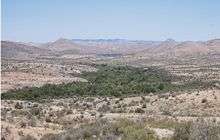Desert riparian

Desert riparian is a North American desert vegetation type (or biome) occurring in the bottoms of canyons and drainages that have water at or near the surface most of the year.[1] It is contrasted with the desert dry wash vegetation type in which water at or near the surface is lacking most of the year.[1] The visual character is of large, lush green trees surrounded by dry desert vegetation and soil coloration.[1] The area may be in a patch surrounding a spring (oasis), or in a strand following the course of water flow.[1] Over 80% of known desert wildlife species use desert riparian areas.[1] Common dominant species include Fremont cottonwood (Populus fremontii), Arizona ash (Fraxinus velutina), arroyo willow (Salix lasiolepis), Goodding's willow (Salix gooddingii), red willow (Salix laevigata), California fan palm (Washingtonia filifera), and invasive species such as salt cedar (Tamarix ramosissima), giant reed (Arundo donax), and Russian olive (Elaeagnus angustifolia).[1] Salt cedar is particularly causing problems for this ecosystem because it is able to extract water more efficiently than cottonwoods and willows.[1] Many noninvasive non-native species may also be found because springs and surface water areas in the desert often were old homesites where such species were intentionally planted, such as elm, black locust, and assorted fruit trees.[1]
See also
References